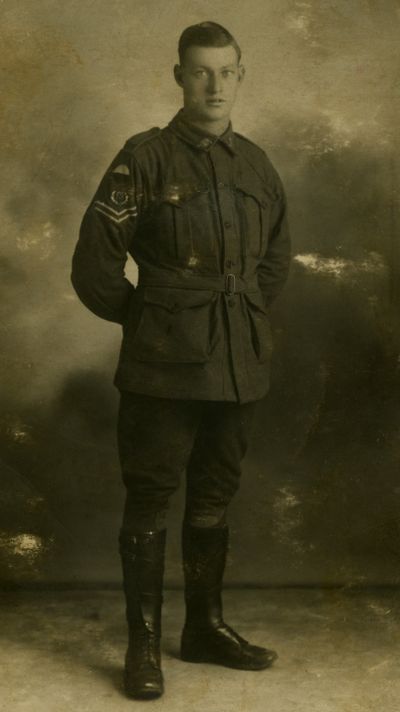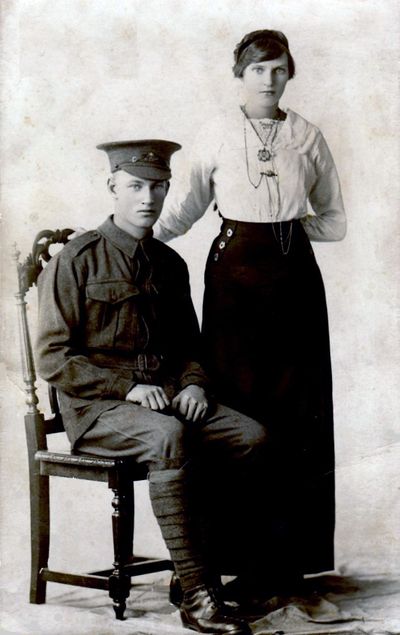Henry McCavana
From Our Contribution
 Courtesy Helen Manson | |
 With Catherine Elizabeth - Courtesy Helen Manson | |
| Personal Information | |
|---|---|
| Date of Birth | unknown 1892 |
| Place of Birth | Fitzroy, Melbourne, Victoria |
| Death | 23 Apr 1945 |
| Place of Death | Royal Perth Hospital, Perth, Western Australia |
| Age at Enlistment | 23 years, 2 months |
| Description |
5' 9½" (1.77m) tall ; 153 lbs 69.4 kg ; fresh complexion ; blue eyes ; light brown hair |
| Occupation | Brickmaker |
| Religion | Church of England |
| Address | Cardup, Beenup, Western Australia |
| Next of Kin | Father , Mr Henry McCavana. Catherine Elizabeth McCavana from Dec 1915 |
| Military Information | |
| Reg Number | 4676 |
| Date of Enlistment | 6 Nov 1915 |
| Rank | Corporal |
| Unit/Formation | 16th Battalion, 14th Reinforcements transferred to 48th Battalion / 12th Brigade, 4th Division |
| Date of Embarkation | 12 Feb 1916 ‒ 11 Mar 1916 |
| Ship Embarked On | HMAT A28 Miltiades |
| Date of Return | 11 Dec 1918 ‒ 20 Jan 1919 |
| Ship Returned On | SS Saxon |
| Fate | Returned to Australia |
| Monument |
Armadale War Memorial (Beenup panel) Armadale and Districts Roll of Honour |
| Medals |
British War Medal Victory Medal |
Pre War
On 22 Dec 1915, Henry married Catherine Elizabeth Thomson at St Paul’s Church West Perth.
War Service
Initial training was undertaken at Blackboy Hill where on 16 Dec 1915 he was allocated to the 14th Reinforcements for the 16th Battalion. Henry embarked on the HMAT A28 Miltiades on 12 Feb 1916 for overseas, arriving at Port Suez on 11 Mar 1916.
He was transferred to the 48th Battalion AIF on 19 April 1916 after spending 29 Mar 1916 in the 3rd Australian General Hospital at Abbassia, Egypt with mild Pyrexia and Influenza, and in the British Red Cross Hospital at Montazah from 9 - 19 Apr 1916. The 48th Battalion was being raised as part of the reorganisation and expansion of the Australian Imperial Force (AIF) following the Gallipoli campaign. Throughout March and April 1916 the battalion undertook training in the desert before being moved to Habieta in early May where they briefly manned defensive positions against a possible Ottoman attack on the Suez Canal.
On 1 Jun 1916, after a march to Serapeum, the Battalion was moved by rail to Alexandria and boarded HMT Caledonia, which sailed for France, docking at Marseilles on 9 Jun 1916, after which they were moved to northern France by rail.
In July and August 1916 the Battalion was variously committed to reserve and front line positions along the Western Front, being in reserve for the Battle of Pozieres, and moved into the front line from 6 Aug 1916, taking part in the next phase, the push from Pozieres to the edge of Mouquet Farm. Henry had been treated at 7th Field Ambulance on 28 Jul 1916 with a scalded foot, and was recuperating in the Rest Station until he rejoined his unit on 16 Aug 1916 at Warloy, after it had been relieved from the front line at Mouquet Farm.
On 31 August the 48th Battalion was again back in the front line at Mouquet Farm before being relieved from that role on 2 Sep 1916. The 48th Battalion, along with most other Australian units had suffered heavy casualties and they were withdrawn from the Somme battlefields and sent north to the Poperinghe area of Belgium to rebuild. Here they combined periods of providing working parties with training, and stints in the front line which at that time was fairly quiet. The enemy often shelled them, causing a lot of work rebuilding the trenches but fortunately causing few casualties.
Henry and his unit were withdrawn from the front line on 23 Oct 1916, and they settled into scarce to find billets at a time when losses due to influenza and other ailments were impacting on the battalion's effectiveness. On 8 Nov 1916, Henry succumbed to influenza, and reported to the 12th Field Ambulance several days before the battalion re-entered the front lines near Fleur. Three days later, when Henry reached the 6th General Hospital in Rouen he was admitted with myalgia as well as influenza. After leaving hospital he injured a knee in a fall at Étaples, France and was transferred to England in May 1917.
He remained in England undertaking guard duty at Tidworth and general duties at a range of Depot and HQ Units at Sutton Veny until he was declared medically unfit [synovitis of the left knee] and returned to Australia on board the SS Saxon on 20 Jan 1919. Henry was discharged by the 5th Military District on 21 Mar 1919.
Post War
The dedication of the Armadale memorial in 1916 was attended by Henry’s wife Catherine Elizabeth McCavana and her mother Mrs Elizabeth Fox, whose son John Edward Thomson was serving with the AIF in France and was named on the memorial.Henry's wife Catherine purchased a small property in Carlisle with the intention of establishing a poultry farm in the future however the timing of this is uncertain but is believed to be when Henry was serving overseas.
Following his war service Henry was again employed at the Brickworks as confirmed by the Electoral Rolls for 1922 and 1925 which show Henry’s address as Beenup State Brickworks, and his wife Catherine is also shown undertaking household duties. Two children were born at this time, Henry James born 1919 and Catherine Thelma 1922. (Thelma was the name of a good friend of Catherine’s who lived in Byford.)
Catherine also lived for a time in Wellington Street, Perth with the two children and in the small cottage at Carlisle on three acres of land surrounded by bush and black sand while Henry continued to work at Beenup, travelling by train to visit the family regularly. He lived in single men’s quarters and also boarded with his brother-in-law, John Thomson who lived in Byford with his family, and who also worked at the Brickworks. Another son, Philip Marshall was born at this time in 1925 and in 1931, at the height of the depression years, another daughter, Bessie May was born.
During the depression years Henry and his family experienced very hard times. He found some employment on Government relief work on public works projects, working two weeks in the country and two weeks off. He was prepared to do any work at all. He found work as a bricklayer and at one time was employed on the construction of Royal Perth Hospital. While employed at Northam, Henry once walked to Perth to visit his family.
Tragedy struck the family on 13 May 1940, when Philip, nearly 15 years of age was accidentally buried by a sand fall when playing at digging an air raid shelter with a group of friends on a vacant block in Harrogate Street. WW2 was taking place and Henry James, the eldest son was serving overseas with the AIF at this time.
In 1940, the family purchased a small grocery shop at 209 Oxford Street, Leederville and moved to this address and operated the small business for several years until about 1949 when it was sold and Catherine moved in with family members. The property in Harrogate Street was rented out for several years and later sold.
Henry died on the 23 Apr 1945 at Royal Perth Hospital from Toxaemia resulting from a small operation at Perth Hospital.
[Information under the heading Post War was kindly provided by Helen Manson]
Notes
Mother was Annie McCavana nee Miller.
External Links